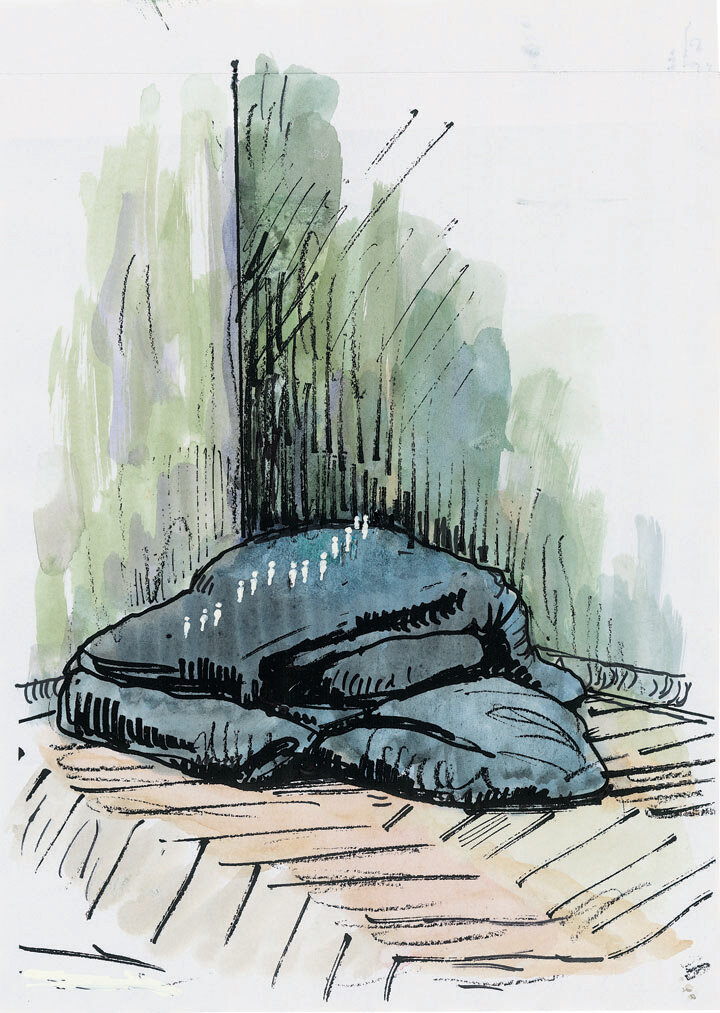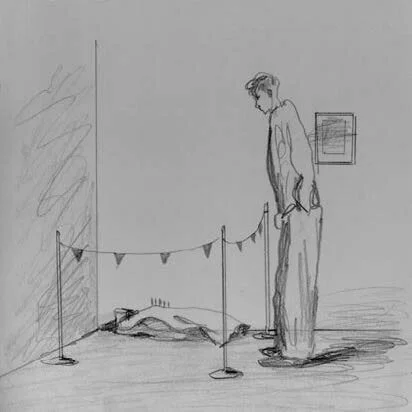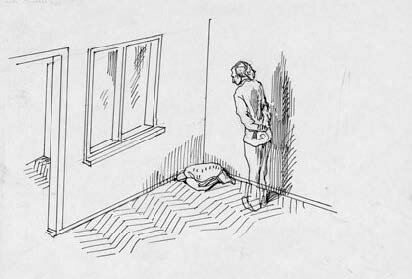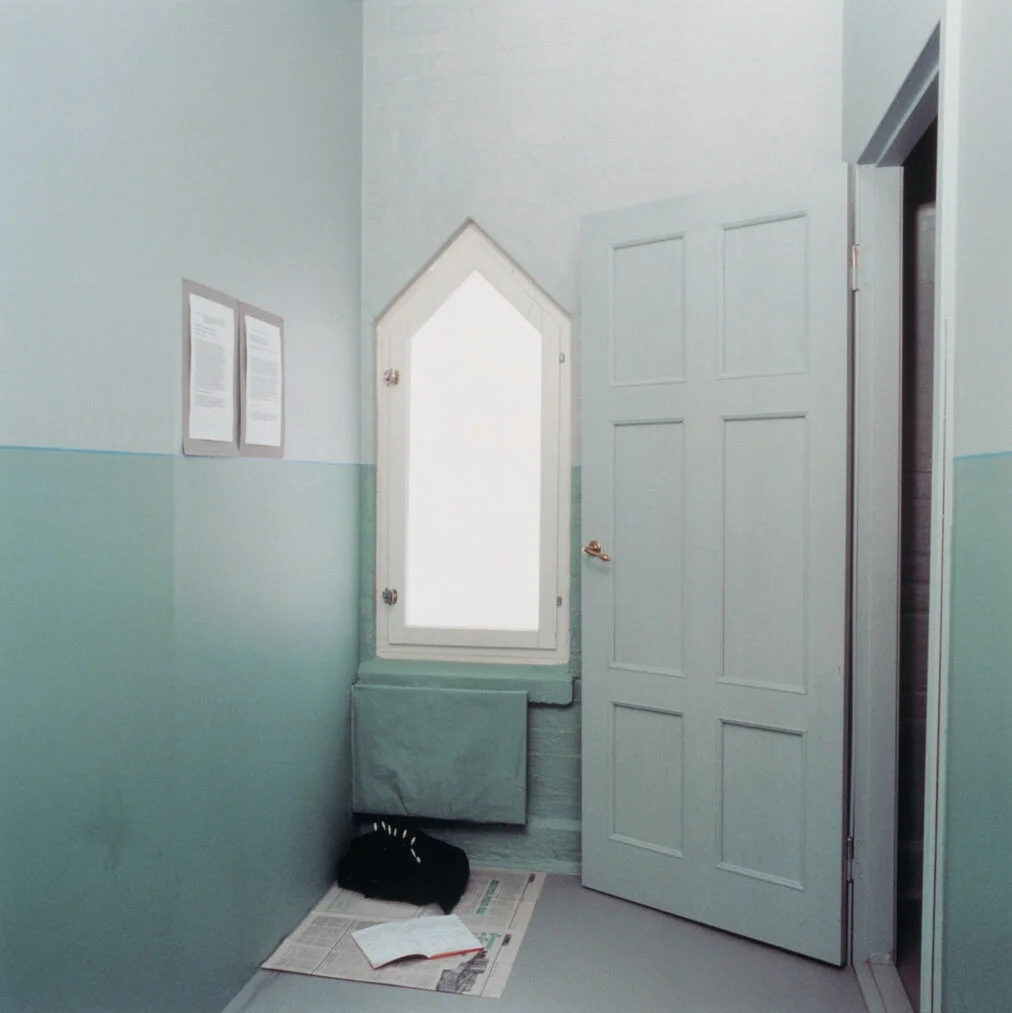Trousers in the Corner
YEAR: 1989
CATALOGUE NUMBER: 26
PROVENANCE
Collection of the artist.
EXHIBITIONS
Version 1
Ilya Kabakov. Que sont ces petits hommes? Galerie de France, Paris, 19 January – 4 March 1989.
Version 2
Trans/Mission – Konst i interkulturell limbo, Rooseum, Center for Contemporary Art, Malmö, 27 August – 27 October 1991 (as part of No 50, Mental Institution or Institute of Creative Research, there under the title Someone Keeps Showing Up in the Corner, Room 6).
See installation “The Mental Institution or the Institute of Creative Research,” Cat No 50.
DESCRIPTION
Trousers that seem to have been dropped casually, are lying on the floor in the corner in the gallery. They are cordoned off by a rope barrier, either to protect the viewer from what is happening or what could happen beyond the barrier, or, on the contrary, to protect the object itself from the viewers. In fact, in this object, in these trousers, there is one special quality: ‘little white men’ are walking along their surface in a row, one after another. There are 18 small flat figures made of paper and having a height of 3 cm. No special lighting is aimed at this ‘object,’ and the viewer can see it completely accidentally by running into it, or he can miss it altogether.
CONCEPT OF THE INSTALLATION
This small installation ‘works’ as a part of a general exhibit that was made in 1989 in the Galerie de France and which was called ‘Que sont ces petits hommes?’ This exhibit included five installations, all different in size. In each of them, however, the same ‘little white men’ participated, each time being arranged differently.
Who are these little white men? This question, placed in the title and on the poster for the exhibit, posed a sort of riddle, the answer to which, along with the interpretation of the objects, was left in the ‘hands’ of the viewer. In all probability, it should connect the content of what was being displayed in the gallery on all three floors with this announced theme. But no matter how you wrack your brain, it is impossible to discover such a connection: the ‘little white men’ were in no way connected either with the three large paintings on the top floor, or with the multitude of pots and pans downstairs in the semi-basement, or with the old furniture, or with the worn trousers, along the surface of which they were marching in single file. There was nothing in common between the actual things arranged in various places in the gallery or even with the space of the large gallery and the ‘little white men.’ They simply and calmly ignore the places they are moving about in, not paying any attention at all to whether they are moving across some surface or simply in the air. Perhaps their relationship to the existing reality of the gallery and everything that stands or hangs in it rests precisely in this ‘ignoring.’
Hence, in these little figures, even though they are almost unnoticeable amidst the large objects of the installations, is manifested the use of a modern term: the idea of the extraneousness of any everyday reality. The presence of another world is announced, perhaps of another humanity living nearby, through, parallel to us, but one that does not even notice our reality.
Of course, this idea is woven from a few images that turned out to be interwoven. Perhaps one of them is the fear of insects along with our simultaneous intrigue as to their existence. This is observed in childhood with the world of ants, and perhaps there is one other heavier and more painful recollection of the times of the evacuation when I lived in the dormitory – the spectacle of repulsive white lice that were quite a common thing in the conditions of filth and neglect in which we lived. (Perhaps this is where the installation Trousers in the Corner arose unconsciously.)
Perhaps, among others, what also emerged were recollections of small soldiers that my mother used to buy for me that included in this small regiment cavalry, generals, artillery, that I would wage entire battles with on the floor in my tiny ‘corner.’ And I would also wage such battles on my chest, on the covers when I would be put to bed. In my right hand would be a foot soldier with a rifle; in my left, a Cossack with a sword; and I would play out their dangerous combat until I fell asleep.
And yet, the idea of ‘another humanity’ in this theme remains the main one, as well as the theme of the movement of this ‘humanity’ through our world. It traverses our world at some angle, in some strangely slanted plane, and departs somewhere, preserving its own structure, its own order. They ‘depart’ like birds do in the fall, maintaining a V-shaped figure in their flight. But we firmly know that they will return in the spring.
But can the same be said with certainty of the ‘little white men?’
Images
Literature






